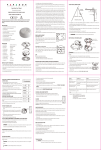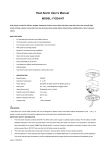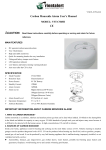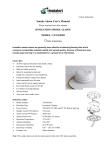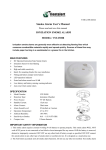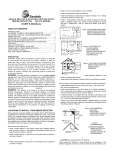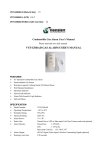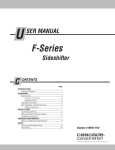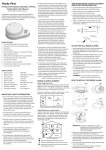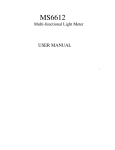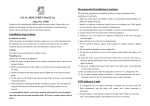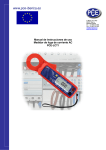Download Heat Alarm User`s Manual
Transcript
Heat Alarm User’s Manual Please read and save this manual WIRELESS FIXED TEMPERATURE HEAT ALARM MODEL: WH588P-AF2/ WH588P-V3E Heat alarms are ideal for kitchens, garages, basements, boilers rooms, attics and other areas where there are normally high levels of fumes, smoke, or dust. These are areas where smoke alarms should not be installed due to risk of false nuisance alarms. MAIN FEATURES DC operated Wireless heat alarm The heat alarm is sensitive only to a fixed temperature Less nuisance alarms due to contamination, dust, and insects Quick fix mounting bracket for easy installation Fitting and battery tamper-resist feature LED operation indicator Low-battery and battery missing indicator Self-test button Auto-hush function when temperature is below alarm point SPECIFICATION Model Number: Operation Temperature: Power Source: Alarm point: Working frequency Emission distance Standby Current: Alarm Current: Alarm Sound Level: Recommended Coverage: Recommended Spacing: Maximum Distance from wall: WARNING WH588P-AF2/ WH588P-V3E -23℃ to 70℃ 9V DC Battery 58℃(135℉) fixed temperature triggers alarm 433/868MHz >150m(open space) 18u A max 18m A max 85 decibels at 3m (10 feet) 232 m2 (2500 square feet ) 15m (50ft) 7.5m (25ft) Heat alarms are not life safety devices and are not designed to detect smoke of fire. Heat alarms detect temperatures of 58℃ (135℉) or greater, and are intended to be used as supplements to smoke alarms by providing early warning. IMPORTANT SAFETY INFORMATION 1. This heat alarm requires a constant working 9-volt battery to operate properly. This heat alarm WILL NOT work if the battery is removed, drained or improperly connected. DO NOT use any other kind of battery except as specified. 2. The Test button accurately tests all heat alarm functions. For temperatures that are below 0℃, use a hand held hair dryer and blow hot air into heat alarm to test. DO NOT use any other test method. Test heat alarm weekly to ensure proper operation. 3. For installation, observe all local and national electrical and building codes. 4. This heat alarm is designed to be used inside a single room building only. In multi-room buildings, each individual living unit should have its own heat alarm. DO NOT install the alarm in non-residential buildings or places which house multiple tenants like hotels, motels, dormitories, hospitals, nursing homes, or group homes. 5. Heat alarms should be used as supplements to smoke alarms in order to provide early warning of heat. In addition, heat alarms should be installed in every bedroom and on every level of the home. This alarm may not always detect slow-smoldering, low-heat producing fires. In addition, heat from a nearby fire may bypass the heat alarm. 6. Heat alarms may not alert every household member every time. The alarm sound of the heat alarm is intended to alert individuals of a potential danger. However, there may be limiting circumstances where a household member may not hear the alarm (i.e. outdoor or indoor noise, sound sleepers, the hard of hearing, etc.). If you suspect that your heat alarm may not alert a household member, install and maintain special heat alarms. 7. This heat alarm can only sound its alarm when it detects temperatures of 58℃ (135℉) or greater. Heat alarms do not detect smoke, flame, or gas .In some fires, hazardous levels of toxic chemicals and smoke can build up before a heat alarm will operate. Temperatures may not reach 58℃ (135℉) to activate the heat alarm QUICKLY ENOUGH to ensure safe escape. 8. Heat alarms have limitations. This heat alarm is not foolproof and is not warranted to protect lives or property from fire. Heat alarms are not a substitute for insurance. Homeowners and renters are responsible for insuring their lives and property. In addition, it is possible for the heat alarm to fail at any time. HEAT ALARM PLACEMENT Heat alarms have an audible warning when the temperature at the alarm reaches 58℃ (135℉). Heat alarms are ideal for kitchens, garages, basements, boilers rooms, attics, and other areas where there are normally high levels of fumes, smoke, or dust. Single-Story Residence Two-Story Residence Key: ●Minimum required smoke alarm locations □Recommended heat alarm locations ○Recommended additional smoke alarm locations HEAT ALARM LOCATIONS 1. Install a heat alarm as close to the center of the ceiling as possible. If this is not practical, mount the alarm no closer than 4 inches from a wall or corner. 2. If ceiling is not practical or the mounting surface may become considerably warmer or if cooler than the room, such as a poorly insulated ceiling, below an unfinished attic or an exterior wall. If local codes allow, install heat alarms on walls, between 4 and 12 inches from ceiling /wall intersections. 3. Install heat alarms on peaked, cathedral, or gabled ceilings 3 feet from the highest point (measured horizontally). 4. In a room with open joists or beams, all ceiling mounted heat alarms shall be located on the bottom of joists or beams – not in channels. 5. Heat alarms installed on an open-joisted ceiling shall have their smooth ceiling spacing reduced to no more than half of the listed spacing when measured at right angles to solid joist. DO NOT INSTALL HEAT ALARMS: : 1. In areas with high humidity, such as bathrooms or areas near dishwashers or washing machines. Install at least 3 meters (10 feet) away from these areas, if possible. 2. Near air returns, heating and cooling supply vents, fans, decorative objects, window molding etc. that may prevent heat from entering the unit thus interrupting its alarm. 3. In rooms where temperatures may fall below -23℃ or rise above 70℃. 4. Near fluorescent lights-electrical noise and flickering may affect the alarm’s operations. WARNING: Incorrect orientation will result in a decrease in operational effectiveness. HOW TO INSTALL THIS HEAT ALARM 1. From back of heat alarm, remove the mounting plate by turning it counterclockwise. (To later the engage tamper-resist feature, twist out and set aside one of the pins molded into plate. Both pins are exactly the same.) 2. Secure plate to ceiling or wall with mounting screws. 3. Lift open battery pocket door. 4. Connect new 9-volt battery to battery connector inside battery pocket. Be sure battery is securely connected. Red LED may blink briefly when battery is installed. 5. Close battery pocket door, snapping it into place. 6. Position heat alarm to mounting plate and turn clockwise to lock into place. To engage the tamper-resist feature, insert pin into notch on edge of heat alarm after alarm is properly positioned in base. NOTE: Heat alarm will not mount to plate if battery is not installed. 7. Push test button to test the heat alarm. See TESTING THE HEAT ALARM. HOW TO SET THE HEAT ALARM INTERCONNECT WITH CONTROL PANEL 1. Find the 6-position dipswitch located on the back of each device. DIP switch function: The 1~6numeric is for coding, total 64 coding. The protection zone is composed by 2 bytes. The high byte is fixed at 170, the low byte is set by the dip switch, starting from. 000 to 063. 2. Using a pen or pencil, change the switches in each of the wireless devices. 3. The protected zone can only be read when the test button is pressed or when the alarm is power on. 4. Please refer to the manual of control panel to add the alarm. CAUTION: Due to the loudness of the alarm, always stand at an arm’s length away from the unit when testing. OPERATING YOUR HEAT ALARM Once the heat alarm has been installed a small. The RED indicator light (LED) will flash approximately once a minute to indicate the battery is healthy and the unit is operating properly. If heat is detected, the unit will emit a load pulsating alarm and a RED indicator light (LED) will be flashing quickly until the detected temperature is below its fixed temperature. TESTING THE HEAT ALARM 1. Test each heat alarm to ensure it is installed correctly and operating properly. 2. The push-to-test button accurately tests functions. Do not use an open flame to test this heat alarm, this might ignite and damage the heat alarm or your home. 3. Test heat alarms weekly and upon returning from vacation or when no one has been in the household for several days. 4. Stand at arm’s length from the heat alarm when testing. TEST ALL HEAT ALARMS WEEKLY BY PERFORMING THE FOLLOWING: 1. Firmly push the TEST button, the heat alarm will sound a loud beep. The alarm will stop sounding after releasing the TEST button. 2. If heat alarm does not sound, please retest it. DANGER: If the alarm sounds, and heat alarm is not being tested, the heat alarm is sensing 58℃ (135℉) or greater temperature. THE SOUND OF THE ALARM REQUIRES YOUR IMMEDIATE ATTENTION AND ACTION. MAINTENANCE AND CLEANING In addition to weekly testing, this heat alarm requires yearly battery replacement and periodic cleaning to remove dust, dirt, and debris. BATTERY REPLACEMENT Replace battery at least once a year or immediately when the low battery signal sounds once a minute. Batteries should be replaced regularly as necessary. WARNING: Do not use any other type of battery, except as specified in this manual. Do not use rechargeable batteries. CAUTION: Explosion could happen if battery is incorrectly replaced. 1. Turn heat alarm counterclockwise to detach it from the mounting plate. 2. Gently pull down heat alarm. 3. Remove battery from the compartment. 4. Insert a new 9-volt battery to connector. NOTE POLARITY OF CONNECTIONS. Ensure the metal tab is fully depressed when the battery has been fitted. 5. Using the Push-to-Test button, test the heat alarm to verify 9V DC battery back-up. See “TESTING THE HEAT ALARM” 6. Reattach the heat alarm to the mounting plate by turning the heat alarm clockwise until it snaps into place. 7. Test the heat alarm using “Test” button. See “TESTING THE HEAT ALARM” CHOOSING A REPLACEMENT BATTERY: The unit requires one standard 9V battery. The following batteries are acceptable as replacements: Golden Power#6F22; Megaton #6F22; New Leader #6F22; Gold Peak #1604; Eveready #522, #1222. Golden Power G6F22; Golden Power GL6F22A CLEANING Clean the heat alarm at least once a month to remove dust, dirt, or debris. Always turn off power to heat alarm before cleaning. Using the soft brush or wand attachment of a vacuum cleaner, vacuum all sides and cover of heat alarm. Be sure all the vents are free of debris. If necessary, use a damp cloth to clean heat alarm cover. WARNING: Do not attempt to remove the cover to clean inside the heat alarm. This will void your warranty. PRACTICE FIRE SAFETY If the heat alarm sounds its alarm horn, and you have not pushed the test button, it is warning of a dangerous situation. Your immediate response is necessary. To prepare for such occurrences, develop family escape plans, discuss them with all household members, and practice them regularly. 1. Expose everyone to the sound of a heat alarm and explain what the sound means. 2. Determine two exits from each room and an escape route to the outside from each exit. 3. Teach all household members to touch the door and use an alternate exit if the door is hot. Instruct them not to open the door if the door is hot. 4. Teach household members to crawl along the floor to stay below dangerous smoke, fumes and gases. 5. Determine a safe meeting place for all members outside the building. WHAT TO DO IN CASE OF FIRE 1. Do not panic; stay calm. 2. Leave the building as quickly as possible. Touch doors to feel if they are hot before opening them. Use an alternate exit if necessary. Crawl along the floor, and do not stop to collect anything. 3. Meet at a pre-arranged meeting place outside the building. 4. Call the fire department from outside the building. 5. Do not go back inside a burning building. Wait for the fire department to arrive. These guidelines will assist you in the event of a fire. However, to reduce the chance that fires will start, practice fire safety rules and prevent hazardous situations. TROUBLESHOOTING WARNING: DO NOT disconnect battery to quiet an unwanted alarm. Problem This will remove your protection. Fan the air or open a window to remove smoke or dust. Possible cause Solution Not all of the alarms/accessories connect with the control panel. Heat alarm beeps with the red LED flash every 45S Manufacturer: Devices may not have power. Check that battery is properly attached to connector. The heat alarm is far away from the control panel. Install the heat alarm close to the control panel. Low-battery Replace battery. See battery replacement in the maintenance and cleaning section. Xiamen Vs-Top Electronics Co., Ltd. 6th floor, Jinzhongda Park, No-666 Yangguang Road, Xinyang Industrial District, Haicang ,Xiamen, China. Tel: 0086-592-6017700 Fax: 0086-592-6017711 E-mail: [email protected] Website: www.orientalert.com









